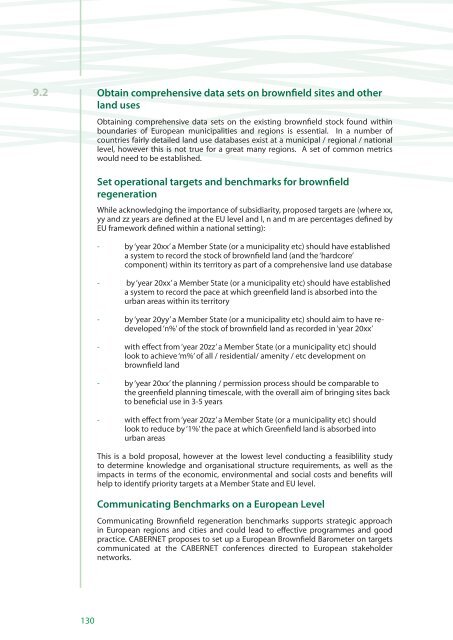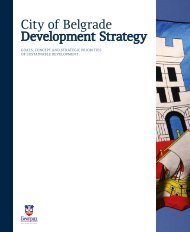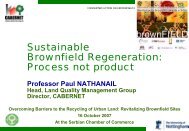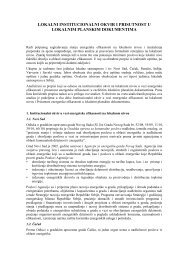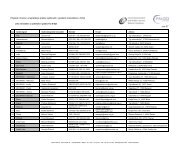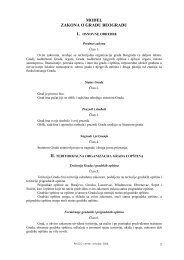Sustainable Brownfield Regeneration: CABERNET Network Report
Sustainable Brownfield Regeneration: CABERNET Network Report
Sustainable Brownfield Regeneration: CABERNET Network Report
Create successful ePaper yourself
Turn your PDF publications into a flip-book with our unique Google optimized e-Paper software.
9.2 Obtain comprehensive data sets on brownfield sites and otherland usesObtaining comprehensive data sets on the existing brownfield stock found withinboundaries of European municipalities and regions is essential. In a number ofcountries fairly detailed land use databases exist at a municipal / regional / nationallevel, however this is not true for a great many regions. A set of common metricswould need to be established.Set operational targets and benchmarks for brownfieldregenerationWhile acknowledging the importance of subsidiarity, proposed targets are (where xx,yy and zz years are defined at the EU level and l, n and m are percentages defined byEU framework defined within a national setting):- by ‘year 20xx’ a Member State (or a municipality etc) should have establisheda system to record the stock of brownfield land (and the ‘hardcore’component) within its territory as part of a comprehensive land use database- by ‘year 20xx’ a Member State (or a municipality etc) should have establisheda system to record the pace at which greenfield land is absorbed into theurban areas within its territory- by ‘year 20yy’ a Member State (or a municipality etc) should aim to have redeveloped‘n%’ of the stock of brownfield land as recorded in ‘year 20xx’- with effect from ‘year 20zz’ a Member State (or a municipality etc) shouldlook to achieve ‘m%’ of all / residential/ amenity / etc development onbrownfield land- by ‘year 20xx’ the planning / permission process should be comparable tothe greenfield planning timescale, with the overall aim of bringing sites backto beneficial use in 3-5 years- with effect from ‘year 20zz’ a Member State (or a municipality etc) shouldlook to reduce by ‘1%’ the pace at which Greenfield land is absorbed intourban areasThis is a bold proposal, however at the lowest level conducting a feasiblility studyto determine knowledge and organisational structure requirements, as well as theimpacts in terms of the economic, environmental and social costs and benefits willhelp to identify priority targets at a Member State and EU level.Communicating Benchmarks on a European LevelCommunicating <strong>Brownfield</strong> regeneration benchmarks supports strategic approachin European regions and cities and could lead to effective programmes and goodpractice. <strong>CABERNET</strong> proposes to set up a European <strong>Brownfield</strong> Barometer on targetscommunicated at the <strong>CABERNET</strong> conferences directed to European stakeholdernetworks.130


